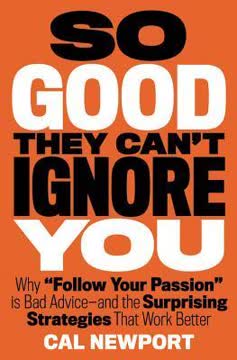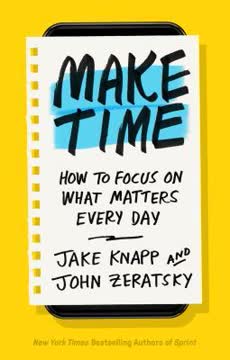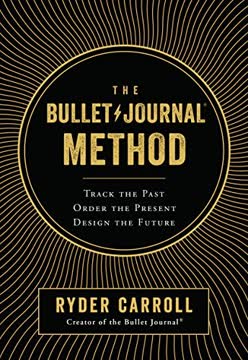重点摘要
1. 子弹日记:数字时代的灵活模拟系统
子弹日记方法的使命是帮助我们关注如何使用生活中最宝贵的两种资源:时间和精力。
应对数字过载的模拟解决方案。 子弹日记方法是一个可定制的组织系统,帮助在一个笔记本中管理任务、事件和笔记。它将生产力、正念和意图结合成一个灵活的框架,适应个人需求。通过提供一个离线空间来处理思维,子弹日记帮助抵御数字干扰的潮流,使用户能够专注于真正重要的事情。
系统的关键组成部分:
- 索引:便于参考的目录
- 未来日志:用于存储未来的任务和事件
- 月度日志:当前月份的时间和任务概览
- 日常日志:用于快速记录每天的内容
子弹日记的美在于其简单性和适应性。用户可以从基本元素开始,随着对系统的熟悉逐渐加入更复杂的功能。
2. 快速记录:高效捕捉思想的符号和标记
快速记录将帮助你高效捕捉生活中的点滴,以便开始研究它。
快速记笔记系统。 快速记录是子弹日记的语言,旨在快速高效地捕捉信息。它使用短形式的符号与标记相结合,将思想分类和优先级划分为三种主要类型:
- 任务:行动项目(•)
- 事件:与日期相关的条目(○)
- 笔记:事实、想法、观察(-)
上下文标记。 额外的符号,称为标记,可以添加以提供更多上下文:
- *(星号)表示优先级
- !(感叹号)表示灵感
这个系统使用户能够快速记录信息,而不打断思维的流动,从而更容易保持组织性并在后续处理信息。
3. 集合:组织信息的模块化构建块
子弹日记的四个核心集合(索引、未来日志、月度日志和日常日志)在大多数情况下都能很好地为你服务。
可定制的组织。 集合是子弹日记的模块化构建块,用于存储相关内容。虽然核心集合提供了坚实的基础,但用户可以根据特定需求创建自定义集合,例如项目规划、习惯追踪或目标设定。
集合的关键方面:
- 灵活性:可以适应各种目的
- 模块化:可以根据需要组合或分离
- 索引:便于查找和参考
自定义集合使用户能够根据独特需求调整他们的子弹日记,使其成为管理生活和工作的多功能工具。
4. 迁移:筛选无意义内容,专注于重要事项
迁移使你避免在自动驾驶模式下运作,避免浪费大量时间在那些对生活没有价值的事情上。
定期审查和转移。 迁移是将未完成的任务和相关信息从一个时间段转移到下一个时间段的过程。这一做法作为内置过滤器,帮助用户识别真正重要的事情并丢弃无关内容。
迁移的好处:
- 减少心理负担
- 鼓励定期反思优先事项
- 防止重要任务被忽视
通过手动重写任务,用户被迫考虑其相关性和重要性。这一有意的过程有助于消除不必要的承诺,将精力集中在有意义的追求上。
5. 反思:培养自我意识和意图
反思是意图的温床。它为我们提供了一个保护的心理环境,让我们重新获得所需的视角,并开始问“为什么”。
定期检查。 反思是子弹日记方法中的一个关键实践,鼓励用户定期审视自己的进展、责任和心理状态。这个过程有助于在日常生活中培养自我意识和意图。
反思的类型:
- 日常反思:早晨(规划)和晚上(回顾)
- 月度反思:在迁移期间
- 年度反思:开始新笔记本时
通过持续的反思,用户可以识别模式,获得洞察,并就如何分配时间和精力做出明智的决策。这一实践有助于弥合行动与信念之间的差距,进而过上更有意图和意义的生活。
6. 目标:将愿望分解为可操作的步骤
目标让我们有机会定义我们想要的东西。
战略性目标设定。 子弹日记方法强调设定有意义的目标,并将其分解为可管理的步骤。这种方法帮助用户将模糊的愿望转化为具体的行动。
目标设定过程:
- 根据个人价值观识别有意义的目标
- 将目标分解为较小的“冲刺”(自包含项目)
- 为每个冲刺创建可操作的任务
- 跟踪进展并根据需要调整
通过专注于更少、更有意义的目标,并将其分解为较小、可实现的步骤,用户可以稳步前进,并在时间上保持动力。
7. 正念:在平凡中寻找意义,练习感恩
意义可以在最不起眼、不可预测和安静的时刻显现出来。
当下意识。 子弹日记方法通过促使用户关注日常经历并在日常时刻中寻找意义来鼓励正念。这一实践有助于培养对生活的更深层次的欣赏,并提高整体幸福感。
正念技巧:
- 感恩记录:定期记录值得感恩的事物
- 清晰记录:重新框定平凡任务以突出其目的
- 有意反思:审视经历以寻找更深层的意义
通过将这些实践融入子弹日记,用户可以培养更具正念的生活方式,从而提高满意度和更强的目标感。
8. 时间管理:通过专注注意力提高生产力
我们时间的质量取决于我们能否保持当下。
战略性时间分配。 子弹日记方法强调有效利用时间的重要性,专注于真正重要的事情。通过优先处理任务并分配专注的注意力,用户可以提高生产力,取得更好的结果。
时间管理技巧:
- 时间盒:为任务分配特定时间段
- 优先级:识别并专注于高影响力活动
- 流状态:创造深度专注工作的条件
通过更有意图地使用时间,用户可以最大化生产力,并在实现目标的过程中取得有意义的进展。
9. 控制:专注于可以改变的事物,放下其余
我们无法控制周围的世界或人,但我们可以控制一些事情,而这很有力量。
斯多葛主义方法。 子弹日记方法融入了斯多葛哲学,鼓励用户专注于可以控制的事物,放下无法控制的。这种心态有助于减少压力,提高日常生活的效率。
控制的领域:
- 对情况的反应
- 个人行为和选择
- 态度和视角
通过将精力集中在可控因素上,用户可以减少挫折感,并在生活中取得有意义的进展,即使在困难的情况下。
10. 坚韧:拥抱不完美和持续改进
拥抱我们的不完美将重点重新放回应该放置的地方:持续改进。
成长心态。 子弹日记方法提倡持续改进和拥抱不完美的心态。这种方法鼓励用户关注进步而非完美,从而实现持续的成长和韧性。
关键原则:
- 改善:进行小的、渐进的改进
- 侘寂:在不完美中寻找美
- 迭代:定期完善过程和方法
通过采用这种心态,用户可以保持动力,克服挫折,并在实现目标的过程中持续取得进展。
最后更新日期:
FAQ
What's "The Bullet Journal Method" by Ryder Carroll about?
- Overview: "The Bullet Journal Method" is a guide to a productivity system that combines organization, mindfulness, and intentionality. It helps users track their past, order their present, and plan their future.
- Purpose: The book aims to help readers become more organized and mindful by using a simple notebook to capture thoughts, tasks, and events.
- System and Practice: It introduces a system of rapid logging and collections, and a practice of reflection and goal setting to enhance productivity and personal growth.
- Community and Flexibility: The method is adaptable to individual needs and has a supportive community that shares various ways to customize the system.
Why should I read "The Bullet Journal Method"?
- Improve Organization: The book offers a structured yet flexible approach to organizing tasks and thoughts, which can help reduce overwhelm and increase productivity.
- Mindfulness and Intentionality: It encourages readers to be more mindful and intentional with their time and energy, leading to a more meaningful life.
- Personal Growth: By reflecting on past actions and setting clear goals, readers can foster personal growth and self-awareness.
- Community Support: The Bullet Journal community provides inspiration and support, making it easier to adopt and adapt the method to personal needs.
What are the key takeaways of "The Bullet Journal Method"?
- Rapid Logging: A quick and efficient way to capture tasks, events, and notes using symbols and short sentences.
- Collections: Modular building blocks that organize related information, such as daily logs, monthly logs, and custom collections.
- Reflection and Migration: Regularly reviewing and migrating tasks to focus on what truly matters and discard distractions.
- Intentional Living: Encourages living with purpose by aligning actions with personal values and goals.
How does the Bullet Journal system work?
- Rapid Logging: Uses symbols to categorize entries into tasks, events, and notes, making it easy to capture and prioritize information.
- Collections: Core collections like the daily log, monthly log, and future log help organize tasks and events over different time frames.
- Indexing: An index at the beginning of the journal helps locate content quickly, making it easy to reference past entries.
- Customization: Users can create custom collections to suit their specific needs, allowing the system to evolve with them.
What is Rapid Logging in the Bullet Journal Method?
- Core Technique: Rapid Logging is the language of the Bullet Journal, using symbols to quickly capture and categorize thoughts.
- Symbols: Tasks are marked with a dot, events with a circle, and notes with a dash, providing context and priority at a glance.
- Efficiency: This method saves time and helps users stay organized by distilling information into concise entries.
- Flexibility: Users can customize symbols and signifiers to suit their personal needs and preferences.
How do Collections work in the Bullet Journal Method?
- Modular Structure: Collections are templates that organize related information, such as tasks, events, and notes, into coherent groups.
- Core Collections: Include the daily log, monthly log, future log, and index, which form the foundation of the Bullet Journal.
- Custom Collections: Users can create their own collections for specific projects or goals, allowing for personalization and adaptability.
- Dynamic Use: Collections can be added, modified, or removed as needed, making the system flexible and responsive to changing needs.
What is the purpose of the Index in the Bullet Journal?
- Content Locator: The Index helps users quickly find specific content within their Bullet Journal by listing topics and page numbers.
- Dynamic Organization: It allows for non-linear organization, enabling users to add new entries and collections without disrupting the flow.
- Subcollections: Users can create subcollections for complex projects, which are also indexed for easy reference.
- Threading: A technique to link related content across different pages or notebooks, enhancing the journal's navigability.
How does the Bullet Journal Method encourage intentional living?
- Reflection: Regular reflection helps users evaluate their tasks and goals, ensuring they align with personal values and priorities.
- Goal Setting: The method emphasizes setting meaningful goals based on curiosity and personal experience, rather than external expectations.
- Mindful Action: By focusing on what truly matters, users can reduce distractions and make more deliberate choices.
- Personal Growth: The practice of intentional living fosters self-awareness and personal development, leading to a more fulfilling life.
What are some best practices for setting up a Bullet Journal?
- Start Simple: Begin with the core collections—daily log, monthly log, future log, and index—to get familiar with the system.
- Customize Gradually: As you become comfortable, introduce custom collections and symbols to tailor the journal to your needs.
- Consistent Reflection: Regularly review and migrate tasks to maintain focus on priorities and discard irrelevant items.
- Community Engagement: Explore the Bullet Journal community for inspiration, support, and new ideas to enhance your practice.
How can the Bullet Journal Method help with personal growth?
- Self-Reflection: Encourages regular reflection on actions and goals, fostering self-awareness and understanding.
- Goal Achievement: Breaks down goals into manageable tasks and sprints, making it easier to track progress and stay motivated.
- Learning from Experience: By documenting successes and failures, users can learn from their experiences and apply insights to future endeavors.
- Empowerment: The method empowers users to take control of their lives by aligning actions with personal values and aspirations.
What are some common challenges when starting a Bullet Journal, and how can they be overcome?
- Overwhelm: Start with the basics and gradually introduce new elements to avoid feeling overwhelmed by the system's flexibility.
- Consistency: Set aside regular times for reflection and journaling to build a consistent habit and maintain momentum.
- Perfectionism: Embrace imperfection and focus on functionality over aesthetics to prevent getting bogged down by appearance.
- Adaptability: Be open to adjusting the system to better suit your needs, and seek inspiration from the community for new ideas.
What are some of the best quotes from "The Bullet Journal Method" and what do they mean?
- "Productivity is about getting more done by working on fewer things." This emphasizes the importance of focusing on meaningful tasks rather than being busy with many.
- "Happiness cannot be pursued, it can only ensue." Suggests that happiness is a by-product of living a meaningful life, not a direct goal.
- "Intentional living is the art of making our own choices before others’ choices make us." Highlights the importance of being proactive in decision-making to align with personal values.
- "The long way is the short way." Encourages taking the time to reflect and plan, as it leads to more effective and efficient outcomes in the long run.
评论
子弹日记法的评价褒贬不一。许多人赞扬其组织系统和正念方法,认为这对提高生产力和自我反思非常有帮助。批评者则认为这本书过于冗长且重复,有些人视其为一种圈钱的手段。读者们欣赏这种方法的灵活性和可定制性,但对书中的哲学内容意见不一。有些人觉得作者的写作风格引人入胜,而另一些人则认为其显得矫揉造作。总体而言,这本书被视为对有兴趣进行子弹日记的人们的实用指南,尽管有些人建议在线资源就足够了。
Similar Books









